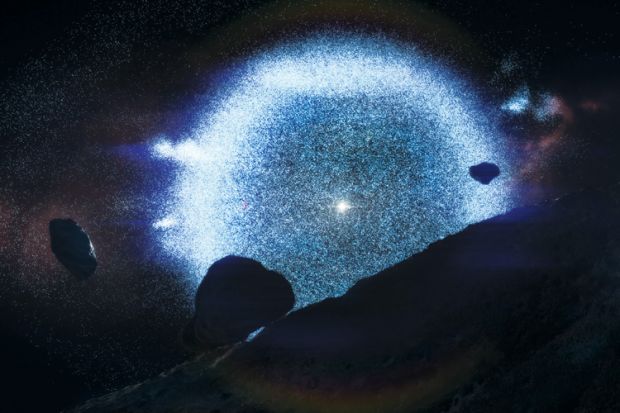On Earth, death rains down from the sky with metronomic regularity. At least, that was the contention of palaeontologists Jack Sepkoski and David Raup. In 1984, they claimed that mass extinctions of life on Earth occur every 30-odd million years.
The obvious culprit is comet impacts. A fragment of comet-ice the size of a terrace of houses disintegrated above Siberia’s Tunguska River in 1908. The blast wave, equivalent to 1,000 Hiroshimas, flattened more than 2,000 sq km of forest. But why should comet impacts occur regularly?
The solar system is embedded in an enormous bee-swarm of comets, so evidently something must stir up this “Oort Cloud” (named for the Dutch astronomer Jan Oort) at regular intervals, sending a flurry of icy bodies sunward, some on a collision course with the Earth. Also in 1984, scientists Michael Rampino and Richard Stothers suggested that the 30-million-year periodicity is related to the solar system’s motion around our galaxy. Think of our Milky Way as a compact disc. The Sun – which is about two-thirds of the way out to the edge – orbits the centre every 240 million years and, as it does so, it bobs up and down through the plane of the CD. Huge stellar nurseries are concentrated in this plane, and it is the gravity of these “giant molecular clouds”, claimed Rampino and Stothers, that stirs up the Oort Cloud every 30 million years.
Lisa Randall does not agree. The eminent theoretical physicist and best-selling science writer contends that giant molecular clouds are not concentrated enough in the galactic plane to create such a well-defined “extinction signal” (and even Rampino and Stothers eventually came to this conclusion). She invokes something else to impart the necessary sharp kick to the Oort Cloud: “dark matter” – the mysterious, invisible stuff that, although you are utterly unaware of it, is flying through you at this very moment.
In fact, you are only reading these words because of dark matter. As the fireball of the Big Bang expanded, the galaxies, including the Milky Way, congealed out of the cooling debris. This happened because regions of the fireball that were slightly denser than average had slightly stronger gravity, enabling them to pull in more matter, which made their gravity even stronger, and so on. But this process – akin to the rich getting richer and the poor poorer – could not possibly have built up a galaxy as big as our Milky Way in the mere 13.82 billion years that have elapsed since the Big Bang. Not, that is, without the help of the gravity of a lot of extra matter: dark matter.
Dark matter outweighs the universe’s visible stars and galaxies by a factor of about 6. It gives out no light (technically, it does not experience the “electromagnetic force” and so gives out no “electromagnetic radiation”). And, crucially, because it cannot shed heat – radiant heat being a form of light – its internal heat, pushing against gravity, prevents it being crushed down to the CD shape of our galaxy. Dark matter therefore lingers in a giant spherical cloud, or “halo”, around the CD. At least, that is what everyone believes – apart from Randall and her collaborators.
Most physicists think that dark matter is composed of hitherto undiscovered subatomic particles that do not interact with ordinary matter, except by pulling on it with the force of gravity. (Dark matter could just as well be made of astrophysical objects such as fridge-sized black holes the mass of Jupiter, but particle physicists, whose subject is currently far more data-poor than astrophysics, have more time on their hands.)
But what if a small fraction of the dark matter particles, despite shunning normal matter, interact with each other via a new force – a “dark electromagnetic force”? If so, they could shed their heat as “dark light”, which would be invisible to us. This is Randall’s contention. If such dark matter particles were heavy enough, they would not linger in the spherical halo of the galaxy, but sink to its central CD-plane. And, as the solar system bobs up and down, their gravity would shake up the Oort Cloud at 30 million-year intervals, creating the comet showers that have extinguished all manner of creatures on Earth, including the dinosaurs 66 million years ago. The smoking gun of that particular mass extinction is the Chicxulub crater, some 180km in diameter, submerged beneath the waves just off the coast of Yucatán in Central America.
You would be forgiven for thinking there are a lot of “ifs” here. Randall’s mechanism works if dark matter is made of subatomic particles; if a small fraction, but not all, are self-interacting; if at least one of them is heavy enough – at least 100 times the mass of a proton – to settle into the CD of the Milky Way and make a sufficiently dense second CD…And that is not to mention if the 30 million-year period of extinctions is actually real. It is notoriously difficult to know from the fossil record how many species existed at any particular time in history and what fraction of them disappeared abruptly.
Randall, however, is a compelling writer who presents a broad range of up-to-date science – everything from particle physics to palaeontology, cell biology to cosmology – in a lively and accessible way. You could do worse than read Dark Matter and the Dinosaurs for this engagingly written overview alone.
Moreover, unlike most scientists, Randall is willing to have fun. Piling speculation on speculation, she explores the way-out science fiction possibilities of her idea. Perhaps, in addition to a dark electromagnetic force, she says, there are dark versions of nature’s two nuclear forces too, and together these glue together dark stars and dark planets, complete with dark life. “Dark objects or dark life could be very close – but if the dark stuff’s net mass isn’t very big, we wouldn’t have any way to know,” says Randall. (For a second, the thought flitted through my mind that there might well be a dark matter family living in my house at this very moment…)
But what of Randall’s central thesis – that a thin disc of dense dark matter periodically roughs up the Oort Cloud and causes mass extinctions? Frankly, I think it is a long shot. The fortunate thing about science, however, is that opinions, including mine, do not matter a jot. Nature is the ultimate arbiter of what is right or wrong. At the end of 2013, Nasa launched its Gaia space experiment, and during its five-year mission it will measure the motions of a billion stars in our galaxy. Since those stars are moving under the gravitational influence of both the visible and invisible stuff, Gaia will enable the creation of a 3D map of the invisible world. Randall’s disc of dark matter will either be there or it will not.
Randall herself is remarkably honest on the book’s opening page. “Though both dark matter and dinosaurs are independently fascinating, you might reasonably suppose that this unseen substance and this popular biological icon are entirely unrelated,” she writes. “And this might well be the case.” But science invariably turns out to be stranger than science fiction. So who knows?
Marcus Chown, formerly a radio astronomer at the California Institute of Technology, is author of What a Wonderful World: Life, the Universe and Everything in a Nutshell (2014).
Dark Matter and the Dinosaurs: The Astounding Interconnectedness of the Universe
By Lisa Randall
Bodley Head, 432pp, £25.00 and £13.99
ISBN 9781847923066 and 9781448192229
Published 12 January 2016
The author
 Lisa Randall is the Frank B. Baird, Jr professor of science in the physics faculty of Harvard University. A highly cited theoretical physicist known for the Randall-Sundrum model, she was named one of Time magazine’s 100 Most Influential People in 2007.
Lisa Randall is the Frank B. Baird, Jr professor of science in the physics faculty of Harvard University. A highly cited theoretical physicist known for the Randall-Sundrum model, she was named one of Time magazine’s 100 Most Influential People in 2007.
Randall was born in Queens, New York. “I definitely think that being in a big city – even if not directly in the centre – affected who I was (but of course that is the only upbringing I had so there is no real basis for comparison!) Certainly by the time I went to high school I had the opportunity to meet a lot of bright students with a wide variety of interests. I also had a good public high school in Manhattan available to me – Stuyvesant, a ‘magnet school’ where you took a test to get in – and public transportation, even though it took a long time to get there. This provided access to more interesting people and environments.
“But I grew up in the time of upheaval in New York City. I joke that my first day of school didn’t exist (there were teacher strikes). So elementary education wasn’t always what it could have been. This probably led me to gravitate toward math and science where there are definite answers (and you can learn a lot on your own).
She recalls being “a very studious child. Perhaps too studious! My mother definitely encouraged me to read and study, and teachers were generally very encouraging, and happy to have a good student. My father also was proud, but maybe thought I studied a bit too much.”
Randall took both her undergraduate and higher degree at Harvard University, and adds, “I guess I was studious then too. I just wanted to do the best I could so I could have options that I’d like available to me after I graduated.”
She has held chairs at both Princeton University and the Massachusetts Institute of Technology, but returned to Harvard in 2001 to take up her present post. “Each institution has its own character, though they also have a lot in common. Most universities have few enough people in each department that particular individuals who are there at the time can have a lot of influence. Also, the particular experience you have depends on which department you are in. But Harvard is more focused on the humanities than MIT while MIT is more focused on engineering, although both attempt to broaden in the other direction. Probably Harvard and Princeton students are more aware of class differences than those at MIT.”
If she were given the power to change one thing about Harvard, Randall says, she “would like to see the university focus more on the people doing outstanding research, and less on the goals of administrators. We would have an even richer intellectual environment if that were the case.”
Dark Matter and the Dinosaurs has already appeared on the New York Times Best Sellers list, echoing the success of previous works including Warped Passages: Unraveling the Mysteries of the Universe’s Hidden Dimensions (2005) and Knocking on Heaven’s Door: How Physics and Scientific Thinking Illuminate the Universe and the Modern World (2011). All have drawn high praise for the clarity and verve with which they present complex topics.
Asked to name academic peers whose writing for a broad audience she admires, Randall says, “I tend to like my friends’ writing, so Maya Jasanoff (history), Ken Rogoff (economics), Daniel Gilbert (psychology) all make the list. For physicists I admire Kip Thorne and Lenny Susskind, who have managed to maintain important scientific research while engaging with the public. I like talking to Lee Smolin, too, who has been very supportive, although we do diverge in our thinking at times. But there are others, too, in both categories.”
Randall’s extensive public engagement includes an active Twitter feed, @lirarandall, and a busy lecturing schedule. Earlier this month she addressed an audience at The Royal Institution on the subject of her new book.
“I think I’m a lot more comfortable in front of an audience than I used to be,” she observes, and adds that the toughest audience “is an unengaged audience. Anyone who voluntarily attends my lecture is usually pretty interested, but sometimes the event will be part of a bigger series and I don't know if people care about science. Audiences usually do ask a lot of questions, but I actually really enjoy that, as I find it a sign they are engaged.”
In 2009, Randall and the Spanish composer Hèctor Parra premiered Hypermusic Prologue: A Projective Opera in Seven Planes, at Paris’ Centre Pompidou. The work was inspired by Randall’s book Warped Passages.
“I learned quite a lot,” Randall says of the collaboration. “Of course one thing I learned was how to write a libretto. My writing tends to be expository and employs longer sentences. Hèctor explained that he needed more duets (conversation of a sort) and shorter phrasings. But I also learned from the artist Matthew Ritchie [who designed the sets] about how to work with existing constraints and how to turn a stage into something wonderful. Performance is very different from paper. Although one character in our opera was confined to a lower dimensional space, he still had to appear interesting. Matthew and I worked creatively to make the lower-dimensional resident’s space alive too.”
Asked to name early career scholars or other collaborators whose work she admires, she says that both “Matthew Reece [assistant professor of physics] and Jakub Scholtz [a postdoctoral fellow at Harvard] both think broadly and in fascinating ways. Matthew is an expert on a wide variety of topics and has interesting things to say about many of them. Jakub has been a pleasure to collaborate with on astrophysical implications of the type of models I think about now.”
What gives Randall hope?
“I like to think that if people know more and are more aware they will make better decisions in the world. At some modest level, I write books for this reason – to make ideas accessible. So I guess the positive response to my books, which are in-depth and can be challenging at times – gives me hope.”
Karen Shook
POSTSCRIPT:
Print headline: The power of the dark side
Register to continue
Why register?
- Registration is free and only takes a moment
- Once registered, you can read 3 articles a month
- Sign up for our newsletter
Subscribe
Or subscribe for unlimited access to:
- Unlimited access to news, views, insights & reviews
- Digital editions
- Digital access to THE’s university and college rankings analysis
Already registered or a current subscriber?




